Request Life-Cycle #
In this section we are going to focus on how requests are processed by Kuzzle. We are going to analyze the life-cycle of a request in order to review Kuzzle server's internal architecture.
Kuzzle has two main modes of communication:
Synchronous: Clients send requests to the Kuzzle server, which processes the data using the Document Controller and then sends a response back to the client.
Asynchronous: Clients subscribe to the Kuzzle server via the Real-time/Subscribe API action and receive data asynchronously as a result of a Real-time/Publish API action or a Document Controller event.
These modes of communication are generally independant from the transport protocol. For example, a synchronous request can be made via HTTP or Websockets.
Synchronous Communication #
In a synchronous request, the Kuzzle server will receive a request, process it, and return the result in a response over the same channel. All this is done sequentially.
Currently all forms of synchronous communication pass through the Document Controller and involve some operation on persistent data: a synchronous request will generally be used to read, create, update, or delete a document.
Depending on the transport protocol used to communicate with the Kuzzle server, different components of the architecture will be used; however, in all cases the data will flow through the Document Controller to and from the storage layer. To demonstrate, we will describe how a "read" request is performed, using two different protocols: HTTP and Websocket. The process is similar for a synchronous update or write.
Synchronous Request using HTTP Protocol #
In the diagram below, we highlighted the components of Kuzzle's server architecture that are used in a read request using HTTP:

The following diagram shows how a request flows between the client application, the different Kuzzle server components, and the external services:
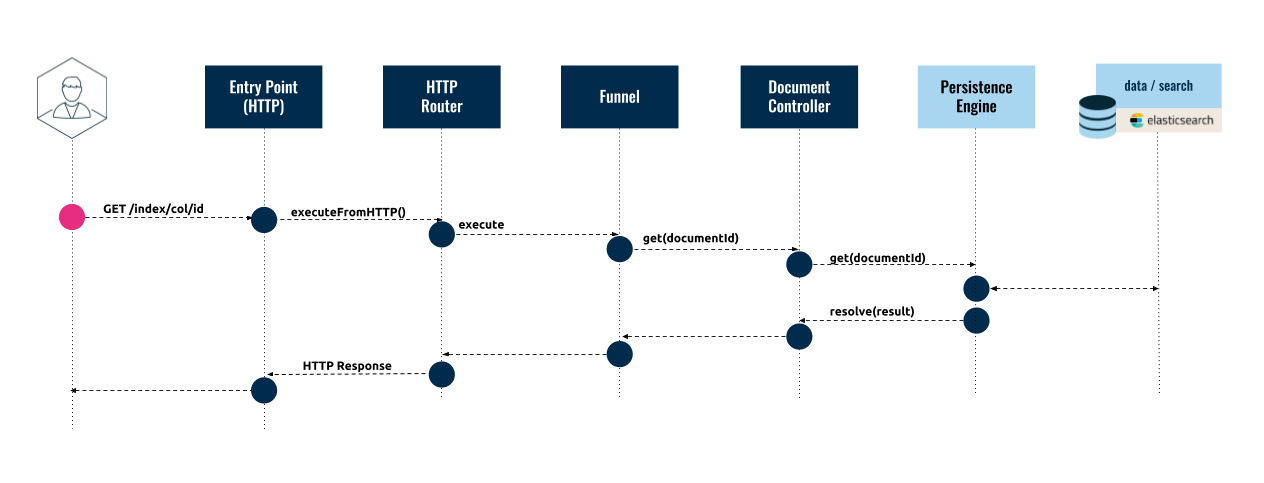
The HTTP client will request a document by making an HTTP GET request. For instance, to retrieve a document with
_idequal to739c26bc-7a09-469a-803d-623c4045b0cbin theuserscollection, the client will perform the following request:GET http://kuzzle:7512/myindex/users/739c26bc-7a09-469a-803d-623c4045b0cb.The Entry Point receives the message and passes it on to the HTTP Router.
The HTTP Router creates a Request Input object and sends it to the Funnel. The
Request Inputwill look like this:
{
"controller": "document",
"action": "get",
"resource": {
"index": "myindex",
"collection": "users",
"_id": "739c26bc-7a09-469a-803d-623c4045b0cb"
}
}The Funnel then validates the formatted data and sends it to the Document Controller.
The Document Controller then requests the document from the Persistence Engine.
The Persistence Engine retrieves the data from the document store (Elasticsearch) and returns a document to the Document Controller which looks like this:
{
"_index": "myindex",
"_type": "users",
"_id": "739c26bc-7a09-469a-803d-623c4045b0cb",
"_version": 1,
"found": true,
"_source": {
"firstName": "Grace",
"lastName": "Hopper",
"age": 85,
"location": {
"lat": 32.692742,
"lon": -97.114127
},
"city": "NYC",
"hobby": "computer"
}
}* The document will make its way through the chain of components until it is received by the client application.
Synchronous Request using Websocket Protocol #
In the diagram below, we highlighted the components of Kuzzle's server architecture that are used in a read request using Websockets:
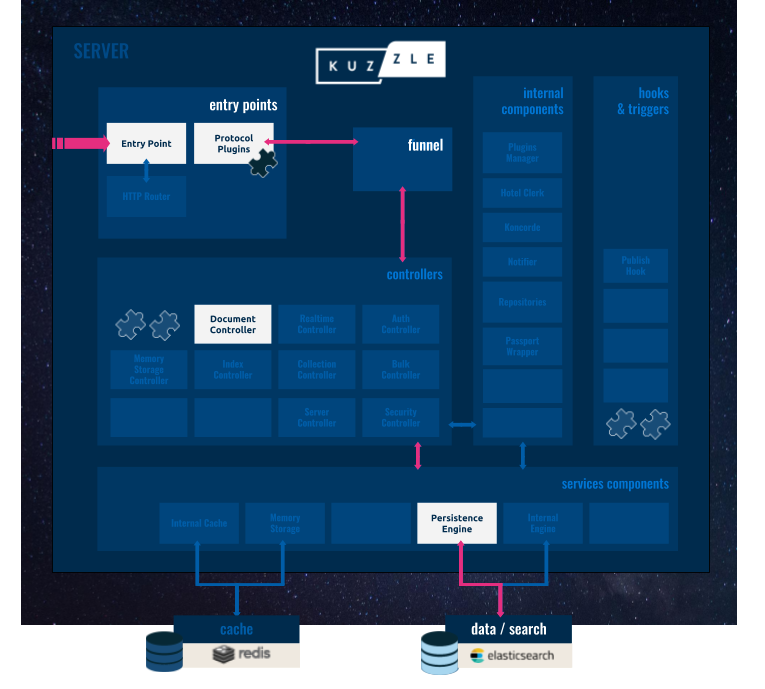
The following diagram shows how a request flows between the client application, the different Kuzzle server components, and the external services:
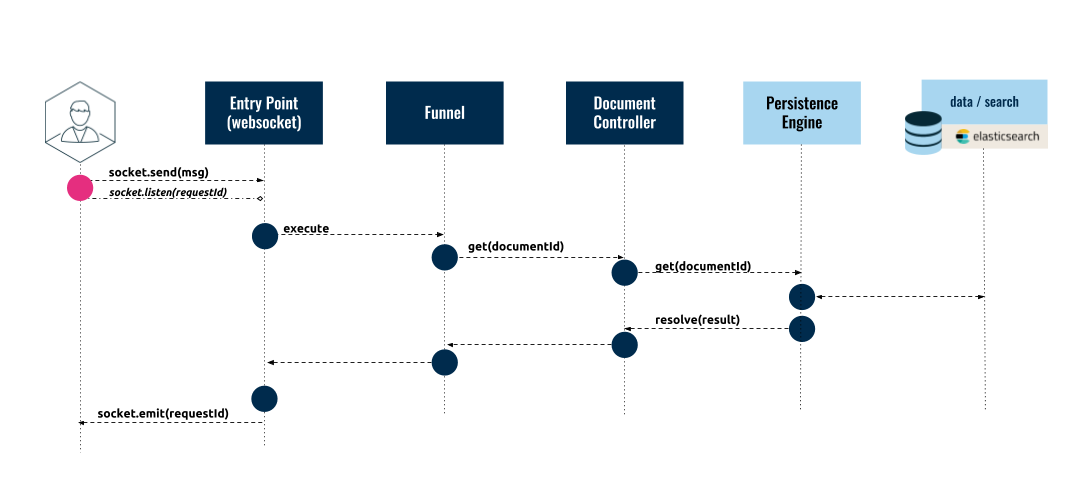
- The client application opens a websocket connection to Kuzzle server and sends a request message. For example, to retrieve a document with
_idequal to739c26bc-7a09-469a-803d-623c4045b0cbin theuserscollection, the client application will send the following message:
{
"requestId": "ed4faaff-253a-464f-a6b3-387af9d8483d",
"index": "myindex",
"controller": "document",
"action": "get",
"collection": "users",
"_id": "739c26bc-7a09-469a-803d-623c4045b0cb"
}* The client application then listens to the `< requestId >` event on the socket. For example:
this.socket.once('ed4faaff-253a-464f-a6b3-387af9d8483d', function(response) {
callback(response);
});* The *Entry Point* receives the message and creates a [Request Input](https://github.com/kuzzleio/kuzzle-common-objects/blob/master/README.md#modelsrequestinput) object which it passes to the *Funnel*. The `Request Input` looks like this:
{
"controller": "read",
"action": "get",
"resource": {
"index": "myindex",
"collection": "users",
"_id": "739c26bc-7a09-469a-803d-623c4045b0cb"
}
}The Funnel then validates the formatted data and sends it to the Document Controller.
The Document Controller then requests the document from the Persistence Engine.
The Persistence Engine retrieves the data from the document store (Elasticsearch) and returns a document to the Document Controller which looks like this:
{
"_index": "myindex",
"_type": "users",
"_id": "739c26bc-7a09-469a-803d-623c4045b0cb",
"_version": 1,
"found": true,
"_source": {
"firstName": "Grace",
"lastName": "Hopper",
"age": 85,
"location": {
"lat": 32.692742,
"lon": -97.114127
},
"city": "NYC",
"hobby": "computer"
}
}The document will make its way back through the chain of components back to the Entry Point.
The Entry Point emits the
< requestId >response and the client application receives it.
Asynchronous Communication #
In an asynchronous request, Kuzzle server will receive a request over one channel, process it, and trigger a response over another channel. In order to receive the response, the Client application must subscribe to the channel. Because two separate channels are used, the request and response do not need to be made by the same client nor do they need to be made sequentially.
This form of communication is generally referred to as publish/subscribe, because on the one side a client is subscribing to a channel and on the other side a client is publishing to a channel.
This subsection describes the life-cycle of real-time notifications which implement the Publish/Subscribe pattern. In the diagram below, we highlighted the components of Kuzzle's server architecture that are used in this pattern: 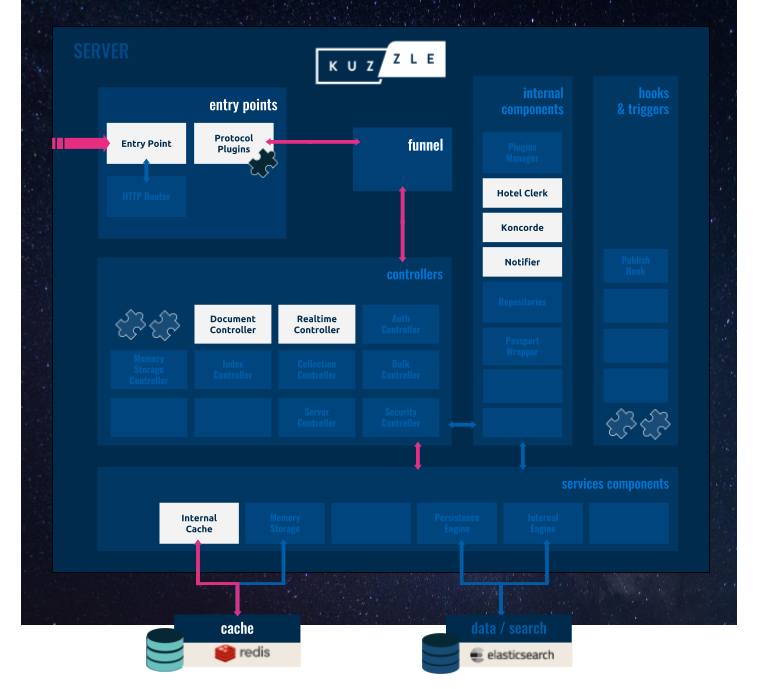
Subscribing to a Channel #
The following diagram shows how a client can subscribe to a channel.
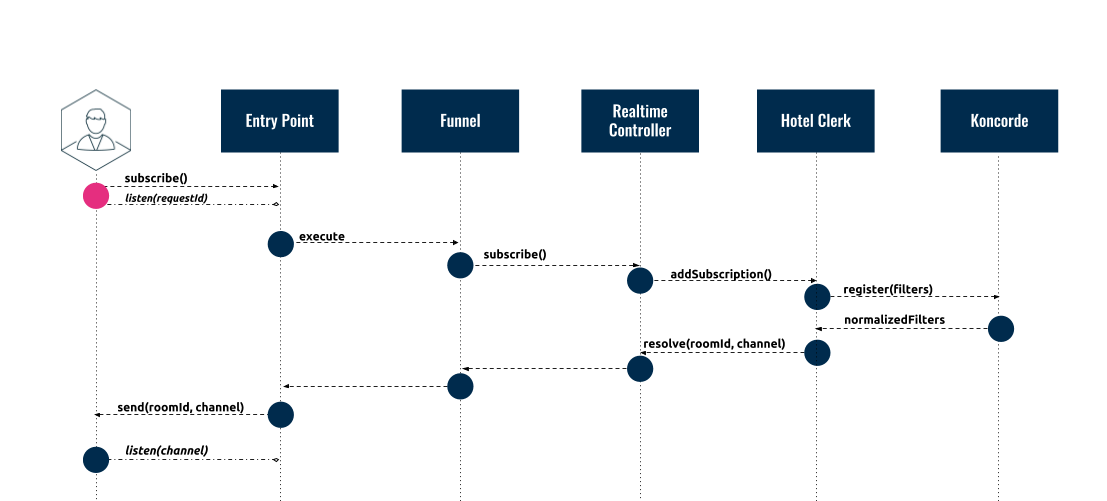
- The client application opens a socket (or MQ) connection, sends a subscription request (see the API Documentation), and then listens for the
< requestId >event on the socket. The subscription request is a message that contains a filter description that defines which events should trigger a response. For instance, the following filter will trigger a response anytime content is posted to theuserscollection that contains the fieldhobbywith valuecomputer(see the Koncorde Reference for more details):
{
"controller": "realtime",
"action": "subscribe",
"index": "myindex",
"collection": "users",
"body": {
"equals": {
"hobby": "computer"
}
},
"state": "all"
}* The Kuzzle server receives the message and the *Entry Point* creates a [Request Input](https://github.com/kuzzleio/kuzzle-common-objects/blob/master/README.md#modelsrequestinput) object with the following format:
{
"controller": "realtime",
"action": "subscribe",
"resource": {
"index": "myindex",
"collection": "users"
},
"body": {
"equals": {
"hobby": "computer"
}
},
"state": "all"
}* The *Entry Point* passes the `Request Input` to the *Funnel*.
The Funnel validates the request and forwards it to the Realtime Controller.
The Realtime Controller registers the subscription with the Hotel Clerk, an internal component that acts as a lookup table of subscribers.
The Hotel Clerk calls Koncorde to normalize the filters and register the subscription (see Koncorde for more details). It then sends a response which includes the
channelID back to the Entry Point.The Entry Point then returns a response to the client, which includes a
< requestId >and thechannelID, and looks like this:
{
"requestId": "ed4faaff-253a-464f-a6b3-387af9d8483d",
"status": 200,
"error": null,
"controller": "realtime",
"action": "subscribe",
"index": "myindex",
"collection": "users",
"result": {
"roomId": "78c5b0ba-fead-4535-945c-8d64a7927459",
"channel": "c5cd8bdc-06a4-4d6e-bae3-61f1a8ac2982"
}
}- The client can now subscribe to the
channeland listen to events in order to be notified any time a message is processed that matches the subscription filters.
Publishing to a Channel Directly #
The following diagram shows how the Kuzzle server triggers a response as a result of a publish request made using the Real-time/Publish action.
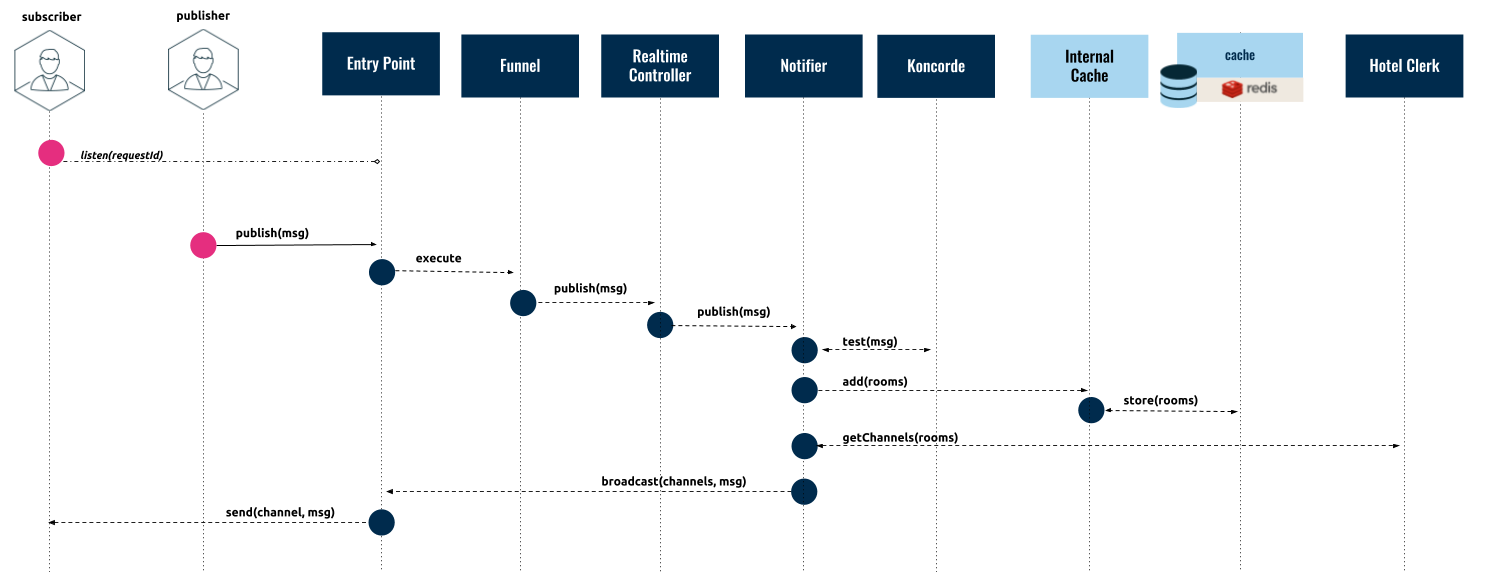
- The Realtime Controller receives the publish request from a client and sends it to the Notifier component.
- The Notifier calls Koncorde to check if the content matches any filters.
- The Notifier uses the Internal Cache to store the mappings into cache.
- The Notifier calls the Hotel Clerk to get the channels related to the filters.
- The Notifier broadcasts the message for each channel that is linked to the filter.
- Finally, the Entry Point emits the message to the clients that are subscribed to it.
Publishing to a Channel Indirectly #
The following diagram shows how Kuzzle uses the Document Controller to trigger a notification as a result of a change in persistent data.
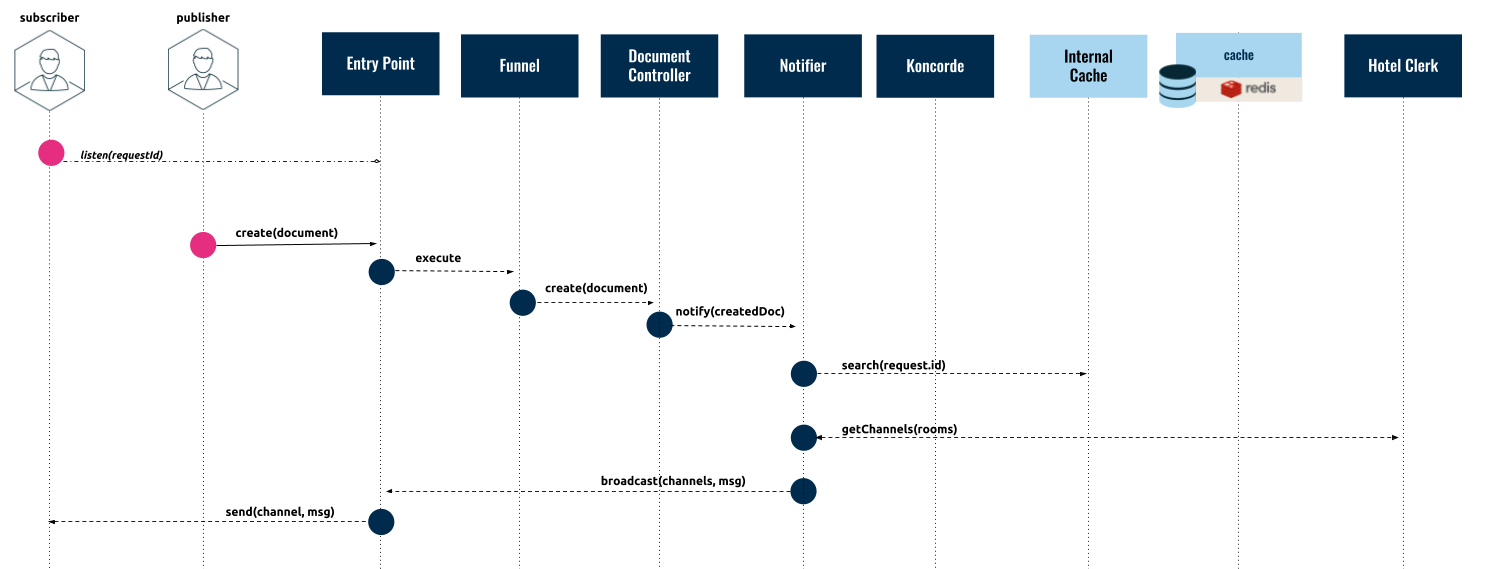
- A client makes a synchronous create request, which goes through the Kuzzle server components to the Document Controller.
- The Document Controller sends the data to the Persistence Engine.
- Once the document is stored, the Document Controller calls the Notifier component.
- The Notifier then calls the Internal Cache to check if the content matches any filters.
- The Notifier calls the Hotel Clerk to get the channels related to the filters.
- The Notifier asks the Entry Point to broadcast the notification to all clients that are subscribed to the channels.